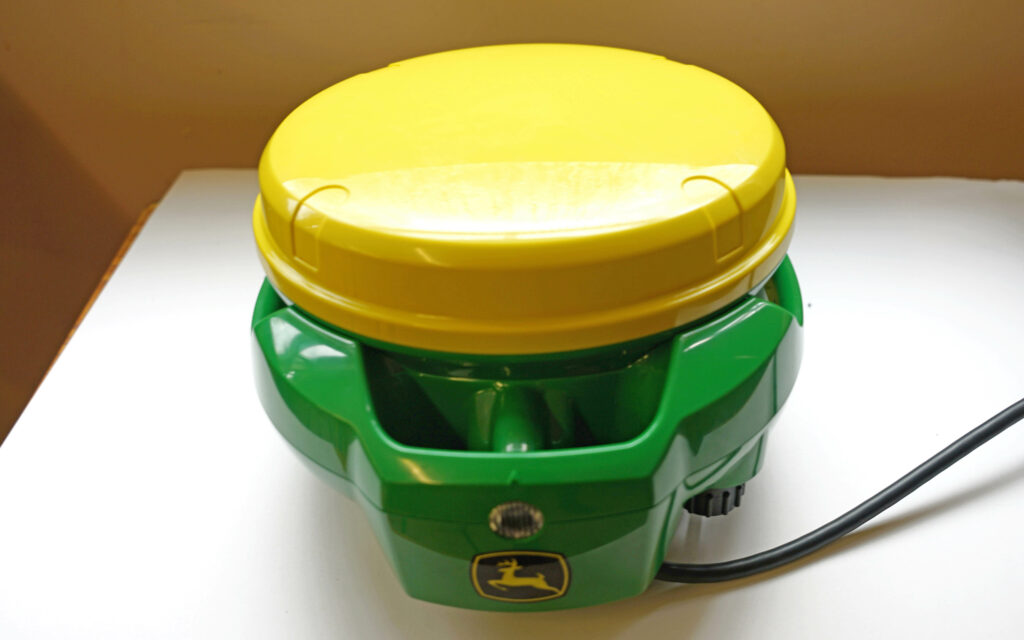As recently reported on Agriland, John Deere is going full steam ahead in not only putting digital technology to work in its products, but also taking the message of what can be done out to its customers.
Recently, the company appointed Orie O’Sullivan as precision ag specialist for Ireland and the UK and charged him with supporting dealers in spreading the precision ag message to their customers.
JD updates its digital tech
As part of this drive, he is delivering a series of presentations to farmers and other relevant groups over the coming months, kicking off at his home town of Tralee, Co. Kerry.

While much of the ground he covered has already been noted here on Agriland, there were some updates to the equipment being offered by John Deere and a fuller explanation of how it all fits together in the digital world.
At the heart of all precision ag systems, irrespective of make, lies the satellite receiver. It is this unit which places the tractor on the map, quite literally, and all things follow from knowing its exact location at any particular time.

Deere’s receivers go by the name of Starfire and the latest to be released is the Starfire 7000 which has undergone a redesign to give it handles for a better grip when removing it from the roof, and the division of its internals into 20 separate components.
These components can be replaced separately rather than having to buy a whole new unit if it is dropped, something which the new handles are designed to help prevent.
More than a digital screen
Following on from the receiver, there needs to be a central processing unit which deals with all the computations necessary to the digital system, and this is found in the back of the screen unit.

Typically, manufacturers talk about the size and clarity of the screen rather than its memory and processing ability, and John Deere is no different in this regard.
Its latest G5 screens are fondly characterised by their size and image rendition with only the barest mention of what goes on in the back of them, yet processing power will become ever more important as the tasks assigned to the software systems multiply in number and complexity.
Performance factors
Having the bare essentials in place, attention turns to the performance of the system, and this is normally expressed in terms of accuracy, a feature which is provided at three levels by John Deere, according to budget.
However, there are two other important factors which affect performance and these are the pull-in times and the repeatability.

The pull-in time is the speed at which the system tunes into the satellites to achieve its claimed accuracy; this may take 20 minutes, or less than one minute – it depends on the system chosen.
While systems may be accurate, it is equally important that that accuracy is repeatable over time, something which might not always be the case. Satellites have an unfortunate habit of drifting, meaning that this movement has to be accounted for.
The three John Deere systems offer day-to-day repeatability, repeatability over a nine-month growing season, or over five years.
HarvestLab brings opportunities
Naturally there is a greater cost as these performance parameters improve, yet the basic level is now free with any M or R type John Deere, a big step forward from when Global Navigation Satellite Systems (GNSS) first appeared on the market.
Once these primary functions are catered for, a whole universe of possibilities opens up and it is this expanding world of options which constitutes the magic of precision ag.
Utilising the known position of a tractor to record the yield of a crop as it is being harvested, has become a routine task, but John Deere claims it has taken the next step forward in analysing the crop as it it comes off the harvester, be it a combine or forager.
Its HarvestLab has been out for a while now, yet its development continues and the reference curves in the software to which it compares the sample are being refined all the time, meaning its accuracy is increasing and is now on a par with results from certified laboratories, according to Orie.

One aspect of this which may grow in prominence is the ability to not just record the physical yield of a combinable crop, but also its protein yield by sector, creating a map of a field’s ability to use nitrogen efficiently.
It may be that the most dramatic shift ushered in by precision ag, and HarvestLab in particular, is that inputs are more finely tuned to specific outputs, not just total yield, and that is a whole new approach to crop management.

